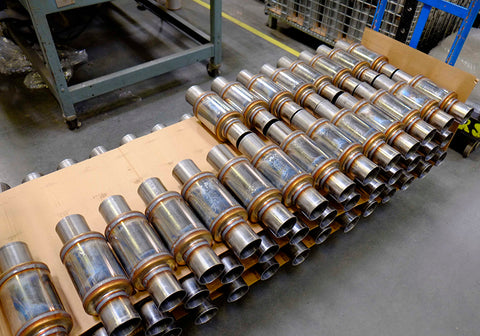MagnaFlow on “How Catalytic Converters Work” Part 1
Few parts on a car are surrounded with more mystery and misconception than the catalytic converter. How could it not be? It’s a sealed box with no user serviceable parts, it’s expensive, and has a somewhat generic sounding name? Why do cats cost so much? How are they made? Hopefully we’ll be able to shed some light on this metal mystery and clear up some confusion with a series of blog posts.
If we’re going to explain how catalytic converters work, first we’re going to have to talk a little about their basic construction. The most important part of a catalytic converter is the ceramic matrix. This honeycomb is made predominantly of a ceramic called cordierite. The honeycomb is created via an extrusion process in which lengths of honeycomb are squeezed through a die and supported by computer controlled jets of air that keep the honeycomb straight as it leaves the machine.
Once the honeycomb is fired and set, it receives a washcoat of various oxides combined with the precious metals that function as the actual catalyst. The washcoat is used because it most evenly disperses the metals throughout all the pores in the ceramic matrix. The metals are generally mixed so as to best utilize their individual properties. Most catalytic converters in the United States use some combination of platinum, palladium, and rhodium. Outside of the US, copper has been tried, but will form dioxin, a toxic substance with carcinogenic properties. In other places in the world, materials like nickel, cerium in washcoat and manganese in cordierite are used but again, each has its disadvantages.
Earlier catalytic converters were of a two-way type, but due to stricter environmental regulations, a more elaborate 3-way converter has become the norm. Cats work using what is called a redox reaction. This means that once the catalyst is up to operating temperature (anywhere from 500 to 1200 degrees Fahrenheit) both an oxidation reaction and reduction reaction are occurring simultaneously. That sounds a little complicated but what it means is that molecules are simultaneously losing and gaining electrons. Redox reactions are extremely common. Things like photosynthesis and rust are both good examples of redox reactions.
The ceramic matrix is fragile, and wouldn’t survive long hanging under a car if it was left to fend for itself. This is where the metal shell comes in. Most catalytic converters feature more than one ceramic “brick” in a shell. The shell helps the cat manage heat and keep the ceramic bricks in their ideal operating temperature range. Between the steel of the shell and the ceramic matrix is a heat resistant insulating barrier that locks the bricks in place inside the shell and limits the amount of vibration that the ceramic sees.
MagnaFlow uses vermiculite based mat for this, though other manufacturers may do things differently. Once assembled, the shells are welded shut and flow tested before being boxed and shipped to retailers and customers. MagnaFlow tests every cat that comes off of our assembly line for air tight performance so you, as a customer or installer, can be sure that it’s going to be good.
In our next article we’ll delve a little deeper into the chemistry of how cats work and why they’re so important in reducing vehicle emissions. We’ll also try and dispel some performance myths about cats.










Comments